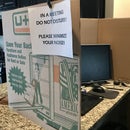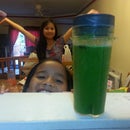Introduction: Big Hero 6 Hiro Hamada and Gogo Tomago Costume
For Halloween, my daughter wanted us to go Trick Or Treating as Big Hero 6 (a 2014 Disney animated film). She's a fan of Gogo Tomago (the girl in the yellow suit) and wanted her brother to be Hiro Hamada (boy in the purple suit). I looked online to see if we can buy any of these two costumes but my search yielded nothing. So I decided to make the costumes myself.
Since sizes would vary from kid to kid, I did not include any templates here but I hope the photos are enough documentation to get you inspired in building these costumes and give you an idea how to go about the process of creating the pieces.
Step 1: What You Will Need
Materials
- Gym puzzle mats (1 pack 5 pcs at Home Depot)
- Craft foam (few pieces of yellow and red)
- Mod Podge gloss finish (8oz)
- Spray Paint (yellow and purple)
- Contact Cement
- Foil
- Duct Tape (yellow)
- Roll of paper
- Pictures of Gogo Tomago and Hiro Hamada in armor
- Styro head prop
- Velcro strips - with adhesive back
- Velcro strips - long, wrap around
- Knee pads
- Grip gloves
- Magnets (4 pcs)
Tools
- Hair dryer
- Paint brush (for applying Mod Podge)
- Sharpie Markers
- Cutter and extra blades
- Steel ruler
- Scissors
Step 2: Create the Helmets
Basic helmet
There's an excellent video tutorial by Evil Ted Smith on YouTube and I followed his instructions in making the base of my helmets. Here's the video link to his tutorial: https://www.youtube.com/watch?v=ODSNPYdvJRo
Take some time to watch his videos so you get an idea on how to go about this step.
- Start by using the styro dummy head (or your child's head if the dummy head is too small) and wrapping the head in foil. DO NOT wrap your child's face with foil! The important impression you need are the top, side, chin, and back of the head.
- Once you've gotten a good mold out of foil, wrap the foil with duct tape. This preserves the pattern better. Be careful not to tape on exposed hair or skin as this will be painful to peel off.
- Mark the the head mold creating a center line from forehead to the back base of the head. Make 2 inch marks. This will make assembly easier for you later.
- Measure 2 inches from the center line down to the side of the head. Do this for both sides. Make 2 inch marks. Label the pattern pieces.
- Remove the mold from the head and cut the pattern. Stretch out the top head pattern strips. The side head pattern is curved following the shape of the head. Cut a line from the middle, outwards to open this pattern making it easier to flatten.
- Transfer the patterns onto paper. Cut out a small notch for every 2 inch pattern you created earlier. This will help you trace these marks on to the foam.
- Pin the paper patterns to the gym foam (smooth side). Trace around the paper pattern. PRO TIP: Pick either one side (left or right) set of patterns to transfer to the foam. Trace one side of the pattern on to the foam, THEN FLIP OVER THE PATTERN so you get a mirror image. Trace this mirror image on to the foam. This will guarantee a more consistent pattern for both sides of your helmet making it uniform.
- Cut the foam according to the pattern. You do not have to cut out the small notches from the 2 inch marks.
- Use the hair dryer to heat the foam. When still hot, bend the foam to a curve to follow the head curve. USE CAUTION AS THE FOAM WILL BE HOT!
- Apply contact cement on both sides of the foam that you will glue together. BE SURE TO OPERATE IN A WELL VENTILATED AREA. Follow contact cement instructions on when to join the pieces together (typical prep time is 15 minutes before you join the pieces together for best results).
- Join the pieces together. Here's where the 2 inch patterns will be helpful. Align these marks to get the best results. Apply pressure to both pieces and hold them together for best bonding results.
- Adjust the helmets when necessary (if it feels tight).
- The chin piece of the helmet should extend forward slightly. It should not touch the wearer's chin but should be wide enough to let the person wear the helmet comfortably. Use extra foam to form the chin.
Details for Gogo Tomago
- Gogo's helmet has a single aerodynamic horn located at the top back portion of the helmet. Cut out 2 piece of triangular gym foam. Curve the foam that touches the helmet so it fits nicely on the rounded surface. Attach this using contact cement.
- Cut a rectangular craft foam and attach this from the top of the visor, flowing on to the tail and behind.
- Apply one layer of Mod Podge. Let it dry.
- Spray paint with Yellow paint.
- Detail the chin portion of the helmet with black sharpie.
- Cut out a circle from red craft foam. Attach these on left and right side of the helmet using contact cement.
Details for Hiro Hamada
- Hiro Hamada's helmet has two antenna fins on each side of the head. Create a paper pattern after these fin antennas and transfer the pattern onto the gym foam. Cut out extra circles to extend the fin antennas out further.
- Attach the fin antennas with contact cement.
- Apply one layer of Mod Podge over the entire helmet. Let it dry.
- Spray paint it with Purple paint.
- Add details to the helmet. Cut out red strips from red craft foam and apply them using contact cement.
Step 3: Build the Chest Armor
For Gogo Tomago
- You will use the yellow craft foam for this piece.
- Make two pieces for the armor: front and back.
- Measure the body across and vertically from shoulder to mid chest.
- Cut out spaces for the neck and arm.
- Join the pieces together and cut out the excess. Mark where the armor pieces overlap.
- Fix/glue one side of the armor by contact cement.
- On the other side, attach Velcro adhesive strips on the shoulder and side.
- Cut out extra foam and fix a shoulder pad and other details on the chest.
- Apply additional detail (red dots) using contact cement.
For Hiro Hamada
- You will use the gym foam for this piece.
- Create a pattern for the front and back piece. They will be identical.
- Cut out the foam according to the pattern.
- Make a curve on the shoulder portion of the armor. I scored the underside of the armor and applied contact cement to preserve the curve.
- Cut out craft foam to form the chest details.
- Use a 1/4 inch drill to start the holes on the shoulders and bottom of the armor. Cut out slit holes big enough for the Velcro straps to slide in.
- Apply Mod Podge over the front and back armor to give it a nice seal.
- Spray paint the armor with purple pain.
- Apply additional detail (red dots) using contact cement.
- Insert the Velcro strips.
Step 4: Build Accessories
For Gogo Tomago
Arm Bracers
- Measure circumference by the wrist and below the elbow of the wearer. Measure the distance between wrist and elbow.
- Transfer measurements on the yellow craft foam. It should resemble the shape of a trapezoid.
- Roll the bracer like a tube and seal the edges by sticking adhesive Velcro on the overlap.
- Place the magnet outside the bracer on top of the forearm. Secure it with yellow duct tape.
Throwing disc
- Use a circular pattern (I used a small plate) and trace it onto a foam board.
- Cut out two circle patterns from foam board.
- Spray yellow paint. Let it dry.
- Attach a magnet to one side of the disc. Make sure the magnetic polarity of the magnet facing outwards matches/attracts the one on the arm bracer. Secure with yellow duct tape.
- Add detail by cutting a smaller circle from red craft foam. Fix the circle onto the center of the disc using contact cement.
Boots
- Measure the circumference of the boot around the leg area. Measure the height of the boot from the heel to the top of the boot.
- Cut yellow foam according to the circumference. Cut out a piece of the foam where the feet of the boot comes out.
- Secure the foam with rubber cement.
- Use the same circular pattern used on the disc and cut out yellow foam using the same pattern.
- Add detail foam (red foam). Secure these detail with rubber cement.
For Hiro Hamada
Shoulder pads
- I bought cheap knee pads from Home depot with removable Velcro elastic strap.
- Apply one layer of Mod Podge. Let it dry.
- Spray paint with Purple paint.
- Apply red dot detail using red foam and rubber cement.
Knee Pads
- I bought cheap knee pads from Home depot with removable Velcro elastic strap.
- Apply one layer of Mod Podge.
- Let it dry.Spray paint with Purple paint.
- Apply red dot detail using red foam and rubber cement.
Gloves
- Find one of those grip gloves at your local hardware. I found one for $15 that had nice patterns above the hand.
- Optional: Create padding above the hand using gym foam. Secure it over the glove with rubber cement.
Step 5: Putting It All Together
Hiro Hamada
- The costume is best worn using a black athletic shirt (long sleeves) and black baggy pants, legs rolled up to the knee, and black shoes.
- My son had a terrific haul from trick or treating. Not sure if the costume helped though!
Gogo Tomago
- The costume is best worn using black leotard, black tights, and boots.
- My daughter was a bit cranky during our trick or treating and decided to sit on the stroller for the duration of the event. Baymax had to push her around!

Participated in the
Halloween Costume Contest 2015











